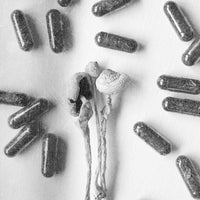With its mini-marts, junk food, zombie flicks and consumer-culture values, modern American civilization is hardly the most nurturing environment for someone whose senses have just been blasted wide open. Consequently, many a psychedelic explorer has sustained a rude shock when returning to the so-called “real world” after a trans-dimensional journey.
So, how can denizens of the fast-paced, tech-saturated western world approach the hard work of psychedelic integration—the act of processing and assimilating psychedelic experiences, adapting to freshly opened states of consciousness and applying entheogenically inspired perspectives to one’s daily life?
Here are some simple actions that can help you make a smooth landing within all the chaos, crises, distractions and destructions of 21st-century America.
Set an Intention Beforehand
As MUD\WTR’s psychedelics expert, Dorna Pourang, points out, “Your ability to integrate [psychedelic experiences] is largely influenced by the preparation.” With that in mind, setting an intention prior to an entheogenic adventure can help lay the groundwork for what comes later. It’s a key part of the “set” in the three primary pillars of psychedelic preparation: dosage, set and setting.
Rest
Plan your journey so that you can spend some quiet time at home afterward. Pourang recommends at least one or two days of post-voyage relaxation.
“If you go and do an ayahuasca ceremony, and then you go back to your super-stressful job and work 20 hours a day the next day, chances are you're not going to integrate a whole lot,” she says.
Pourang adds that this can be an exhausting process, so it’s critical that you get good sleep to replenish your system and promote neuroprotection. She also emphasizes the importance of having tools for self-soothing. Some examples of this are comfortable clothing, a blanket to wrap yourself in, walks in sunshine and nature, binaural beats and warm beverages or soups.
Create a Serene Home Environment
Make your home a sanctuary. Use things like candles, tapestries, plants and calming music—especially music you may have listened to during your psychedelic experience—to create a tranquil, positive setting.
Find a Support Network
This can be helpful for anyone who has recently gone through a powerful psychedelic journey, but especially for those who live in areas that may not be compatible with a raw, impressionable state of consciousness. Along with close friends, your support network might consist of meetups, integration circles and/or a trained integration therapist. According to Pourang, the last of these can be particularly helpful during some of the more difficult junctures of the integration process, especially if you feel unstable and are having difficulty processing your emotions.
“You are not alone in this feeling, and it is not uncommon to not feel 100 percent amazing after a psychedelic experience, especially if your intention was to heal some difficult wounds,” she says.
Some links for support network outlets can be found here. Pourang also mentions that psychedelic.support has a well-vetted repository of trained therapists who specialize in psychedelics.
Building a strong support network may also involve minimizing contact with unsupportive people. Make a point of setting boundaries with relationships that compromise your mental health.
Eat Intuitively and Minimize Processed Foods
In an already stressful environment, the last thing anyone needs when they’re fresh back from the luminous, numinous Source is toxic food that may increase stress. Instead, choose foods that support well-being.
“Gut bacteria produces and responds to neurochemicals such as serotonin and dopamine, and this is influenced by diet,” Pourang notes.
Minimize Negative Self-talk During Psychedelic Integration
With all its temptations and demands, our culture offers endless opportunities to cut corners in your integration work. If this happens, you might catch yourself thinking self-critical thoughts like, “I’m an idiot for eating that junk food,” or “I should have slept more.” Pourang recommends staying hyper-aware of this kind of negative self-talk and taking measures to minimize it as you shift into a new way of being.
“Discipline is good for you if it supports your wellbeing—i.e., maintaining a wellness routine—but don't conflate that with unnecessary critical self-hatred,” she warns. “Make sure you really are very gentle with yourself and very accepting of yourself, because we're doing some of the hardest work that can be done.”
Use Practices Like Meditation, Mindfulness, Breathwork or Yoga
Again, these are good practices for most anyone who is decompressing after a deeply meaningful trip, but especially for those who live and work in high-pressure, high-tech environments. Take the time to defrag, unclutter, shake off the day residues and get yourself aligned in spine and mind.
Write
According to Pourang, journaling and writing things down is a helpful way of processing a psychedelic experience. “You can start absolutely anywhere—i.e., “I saw the color blue...”—and don't lift your pen from the paper for five minutes, even if you feel like you're jotting down nonsense,” she suggests. “You'd be surprised at what flows out.”
Keep Going
As Pourang observes, you’ll hear people say they're still integrating their first psychedelic experiences from ten or 20 years ago. In her view, integration isn’t a one-shot deal, but a lifelong maintenance process.
By way of analogy, she offers, “Let's say you're trying to tackle a medicalized health issue like blood pressure or diabetes, and a person needs to lose a lot of weight. There's not a set amount of time that you can take to lose a lot of weight; it is a lifestyle that has to change around that.”
The same goes for psychedelic integration. “It's mental hygiene,” Pourang says.
Dr. Katherine Lawson, MA, PhD, says the psychedelic integration work she does with her clients can take one session or several months depending on what is uncovered. “The important piece is the honoring of what happened and giving it as much time as it merits,” she explains.
She adds that integration is a part of the journey and therefore cannot be overlooked. “Just as one puts time and focus into choosing the right medicine, facilitator, intention and setting, one must be dedicated to an integration process.”
Damon Orion is a writer, musician, artist, and teacher based in Santa Cruz, CA. He has written for Revolver, Spirituality & Health, Guitar World, High Times, Classic Rock and other publications. Read more of his work at damonorion.com.
Photo by Alina Grubnyak on Unsplash
Read More: What Psychedelic Researchers Are Learning About Mental Health
Read More: How to Gratitude Journal
Read More: What Is Mental Health Hygiene?




